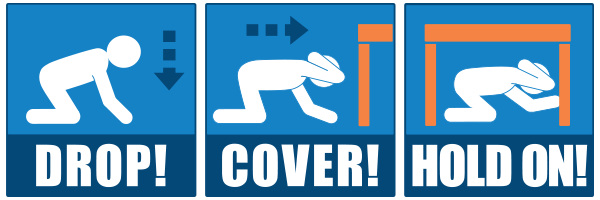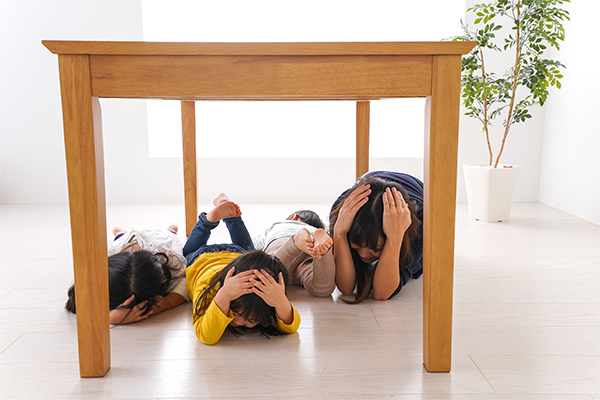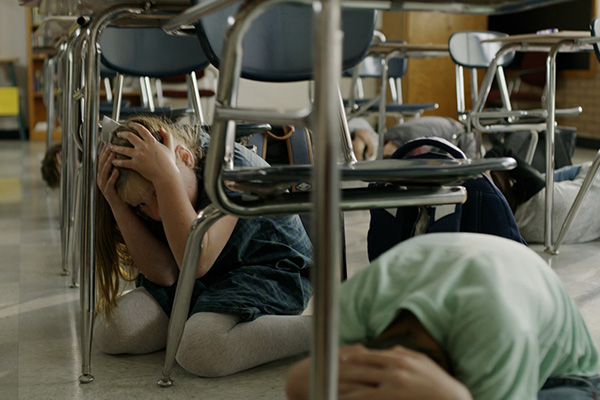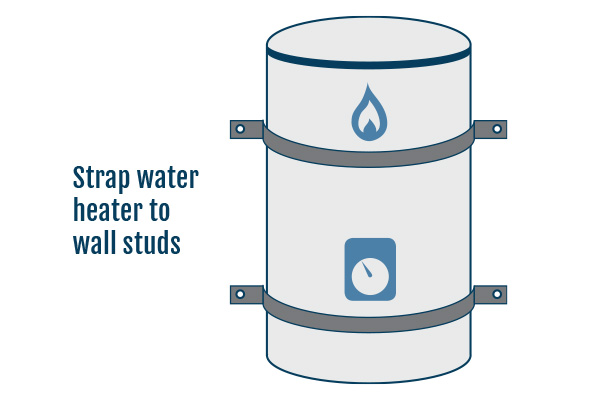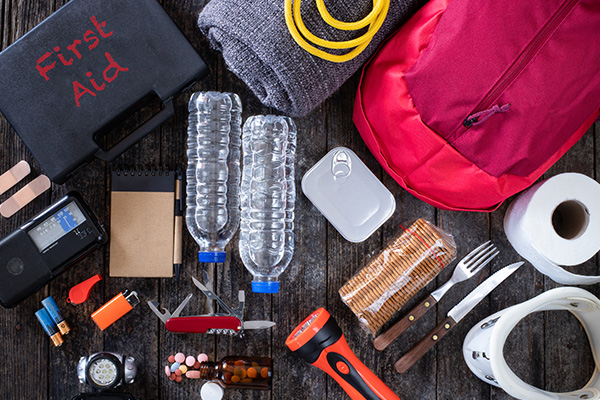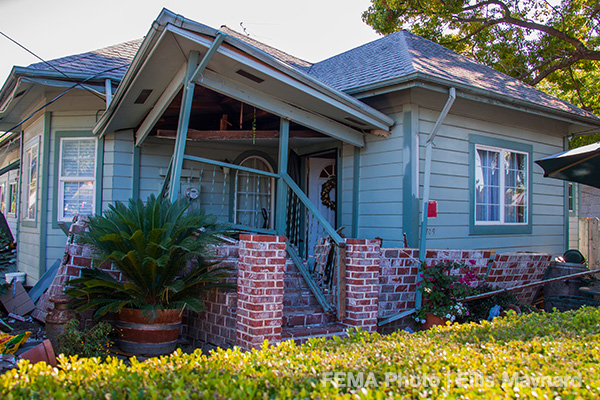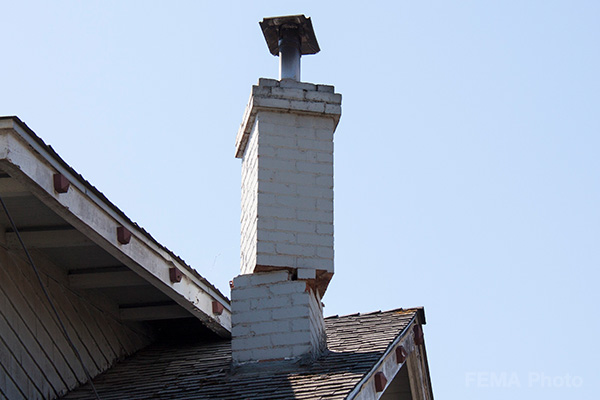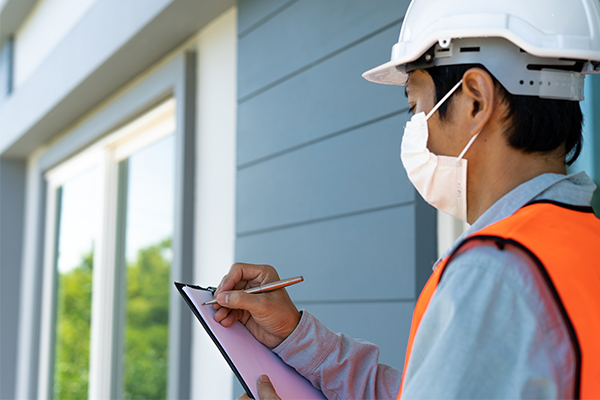Earthquakes cannot be predicted and when they occur, there is no warning. While we can’t prevent quakes from happening, we can prepare ourselves for when they strike by knowing what to do during an earthquake at home.
As the Great ShakeOut site explains, earthquake shaking can be so strong that you cannot run or crawl because you might be knocked straight to the ground. Experts suggest it is best to drop to the ground before the earthquake drops you to the ground. If possible, find nearby cover—or if there is no nearby cover or shelter, use your arms and hands to protect your head and neck. Drop, cover, and hold on gives you the best chance of quickly protecting yourself in a quake. Always be prepared with emergency plans and supplies and don’t forget to sign up for the MyShake app, which, when enabled, can alert your phone that a quake in your area has begun, and shaking is imminent.
How to stay safe during an earthquake
If you are inside your home during a quake, you should get under your dining room table, a desk, or another piece of heavy furniture that has an area underneath to crawl into and drop, cover, and hold on to the leg of the furniture. If there isn’t a table or desk near you, crouch wherever you are and always remember to protect and cover your neck. Stay in place and inside your home until the shaking stops.
3 steps to stay protected
The most basic quake survival steps are drop, cover, and hold on. Other things you should do in a temblor are to drop down and make yourself as small as possible. Don’t try and run for cover. That works in the movies, not in real life.
Drop
Drop where you are onto your hands and knees. The position protects you from being knocked down and allows you to stay low and crawl to shelter if nearby. It can also protect you from flying objects.
Cover
If a sturdy table or desk is nearby, crawl underneath it and cover your head and neck with your arms. If no shelter is nearby, crawl next to an interior wall or an inside corner of your house or the building you are in. Avoid sheltering near any windows. Stay on your knees and bend over to protect other parts of your body.
Hold On
Once under some type of shelter, hold on to your shelter with one hand and be ready to move with your shelter if it shifts during the shaking. If there is no nearby shelter, cover your head and neck with both arms and hands. Stay in place until the shaking stops. Research shows that most earthquake-related injuries result from collapsing walls, falling objects and flying glass caused by the ground shaking. Common quake-related injuries include wound infections, fractures, dislocations and head, face and brain injuries. So, if you are inside your home or a building when the ground starts shaking, it is best to stay put and do not move to a different location.
Where are the Safest Places to be During an Earthquake?
What to do in an earthquake at home
According to shakeout.org, if you are inside your home during an earthquake, the safest place to drop, cover, and hold on until the shaking stops is beneath a sturdy desk or table, if there is one nearby. If you are not near a sturdy desk or table, it’s best to drop where you are onto your hands and knees. By doing this, you are protecting yourself from being knocked to the ground. This also allows you to stay low and crawl to shelter, if there is shelter nearby.
If you are in bed during an earthquake, the safest thing to do is cover your head and neck and stay there until the shaking stops. In most homes, doorways are no stronger than any other part of the house and the doorway may not protect you from the most likely source of injury—falling or flying objects or debris.
Is going outside during an earthquake safe?
If you are inside your home during an earthquake, stay there. Do not try to seek safety outside.
What if I am outdoors?
If you happen to be outside during a quake, it is important to get away from buildings, which can collapse. Stay in an open area such as a field where there are no trees, buildings or power lines.
What if I am in a car?
Experiencing the shaking from an earthquake while in a moving vehicle has been compared by some people to driving on four flat tires. With that in mind, Westways, the member magazine for the Auto Club of Southern California, offered several tips in an article to prepare vehicle drivers if an earthquake occurs while driving.
What should I do if there's an earthquake at school?
If your children are at school during an earthquake, the same tips apply as if they are at home: get under their desk or a table and drop, cover, and hold on. Most schools have regular earthquake preparedness drills in which children are reminded to drop, cover, and hold on.
To improve your earthquake readiness, practice drop, cover, and hold on with your family, coworkers and friends. Literally millions of schools, businesses and other groups in California participate in the annual Great California Shakeout earthquake drill each October.
What if you are in a building during a quake?
Whether you are at home, school or working inside an office building, the same preparedness recommendations apply—get under a desk or table and drop, cover, and hold on. If there is an elevator in your office building, you should not use it. Take the stairs instead, even when the shaking stops, as there might be aftershocks.
Earthquake safety tips for people with disabilities and Access and Functional Needs (AFN)
People with disabilities and others with Access and Functional Needs (AFN) may need to modify how to drop, cover, and hold on. If you have difficulty getting onto the ground or cannot get back up again without the help of a caregiver, you can learn more on how to adapt to your situation during a quake by reading this information provided by the Earthquake Country Alliance.
How can you prepare your house to be more secure during an earthquake?
While we don’t know when a quake will occur, there are steps you can take to prepare for a major shaker while at home and reduce the chance of bodily damage and damage to your property. The biggest threat of injury inside your home comes from flying or falling objects. Those objects include bookcases, televisions, lamps and water heaters. You can add to this list just about anything in your house that is not anchored or secured.
Securing those movable objects before the shaking occurs can go a long way in preventing injuries and protecting property. When it comes to how to stay safe in a quake, it is also a good idea to determine if your home is in need of a seismic retrofit.
Secure large furniture and other household items
Secure large, heavy furniture to walls with flexible straps. Use earthquake fasteners or Velcro fasteners for objects on tables, shelves or other furniture. Install safety latches on cabinets to keep them closed.
Secure water heaters
It is important to secure your water heater with earthquake straps. In California, the state Plumbing Code requires that all water heaters be supported and strapped to prevent movement during a quake. More instructions and information on how to secure your space are available from the Earthquake Country Alliance.
Consider a Seismic Retrofit for Your House
If you live in a home built before 1980, there is a good chance it needs to be strengthened to make it more resistant to earthquake shaking. There are more than one million of these older homes in the Golden State, which were built before the implementation of stronger building codes. Seismic retrofitting, which is a process of bracing and bolting your home to its foundation, can make your home more resistant to the strong shaking caused by major earthquakes. Retrofitting may be well worth the investment.
What should you have ready in the case of an earthquake?
Preparing for an earthquake is a worthwhile opportunity for you and your family to talk about what you should do when a major earthquake strikes. Creating an earthquake kit should be a part of that preparation. The Federal Emergency Management Agency (FEMA) and the Red Cross recommend that you store enough food, water and other supplies for a minimum of 72 hours (three days) for your household. This can help you survive the initial, most crucial time period after a major shaker.
What items should be in an earthquake kit or “go bag”?
Consider your quake kit or “go bag” to be your shelter-in-place survival kit. The earthquake kit supplies go in a box, backpack or designated earthquake bag inside your home. Keep this kit accessible and in a place where you can get to it when an earthquake strikes. Check out our blog post for a list of critical supplies and what items should be in an earthquake kit.
How do we make our existing houses earthquake resilient?
Millions of homes in California were built before modern seismic building codes were put in place. With a greater than 99 percent chance of one or more major shakers striking our great state in the next 30 years*, it is important that these older homes are strengthened to become more quake-resistant through the process of seismic retrofitting.
A seismic retrofit of older homes can lessen the potential for structural damage. Make your existing house earthquake resilient by strengthening it with a seismic retrofit. Read more on our blog Protecting Your House from Earthquake Damage.
What to do after an earthquake
In the immediate aftermath of a shaker, it is important to check yourself and others around you for injuries and, if you can, provide first aid to those who need it. If there are seriously injured people in your vicinity, call 9-1-1 if possible. It’s also important to listen to the radio, watch television or follow social media for important news, information and instructions regarding the temblor and the extent of damage it has caused. You also should expect aftershocks and be prepared to repeat drop, cover, and hold on. Here is a more comprehensive list of what to do after an earthquake.
What is your earthquake risk?
Every area of California has earthquake risk. The Golden State has more than 15,000 known faults and more are being discovered. One of California’s most devastating earthquakes occurred in January 1994 in the San Fernando Valley community of Northridge on a fault that was unknown at the time.
Begin preparing for an earthquake by knowing your home’s weak spots and what earthquake hazards are near your home. The USGS's interactive fault map can explain what faults run through your area and give you a better understanding of the potential for structural damage to your home.
How to keep your family safe
Most Californians live within 30 miles of an active fault. So it is important to know other ways to help protect your home and your family in the event of a major quake. Visit the American Red Cross website for additional information and tips.
Learn the Seven Earthquake Safety Steps
No one can predict when or where the next major shaker will occur, but you and your family can be prepared before it strikes. Useful earthquake preparation tips can help you to create a plan. These seven steps to earthquake safety can be found on our Seven Earthquake Safety Tips page.
How to protect your home
You can take steps to reduce damage to your home by and improve your family’s chances of staying safe in an earthquake by advance planning. Those steps include: know your risk for quakes in your area; create a safety plan for you, your loved ones and your pets; purchase an earthquake safety kit and place it in an accessible place in your home; repair potential quake hazards in your home; secure fixtures, furniture and other items; and determine if your house is in need of retrofitting.
Determine your structural risks
If you live in California and your house was built before 1980, earthquake experts say your home may be especially vulnerable to damage from earthquake shaking because it was built before modern seismic building codes were established. The frames of many of these types of homes are not bolted to their foundations. And without adequate bracing and bolting, these houses can slide or topple off their foundation during an earthquake. Chimneys also are vulnerable to earthquake damage, and repairs can be expensive.
Look up your house type to learn its vulnerabilities and more about how to strengthen your house.
Strengthen your home!
Strengthening your house with a seismic retrofit is a good way to help prevent costly earthquake damage. It can help provide peace of mind, knowing that you have helped your family better withstand a quake by strengthening where you live.
The earthquake retrofit process can be straightforward and often not as intrusive as homeowners might think. Depending on the type of home, the work usually can be done in a few days and homeowners can remain inside their dwelling, as workers usually do not need access to the inside of the residence. If your house is older, odds are it may need a seismic retrofit to have a better chance to withstand quake damage. To learn more about the earthquake retrofit process, check out Strengthen My House.
*According to the third Uniform California Earthquake Rupture Forecast (UCERF3) report.

